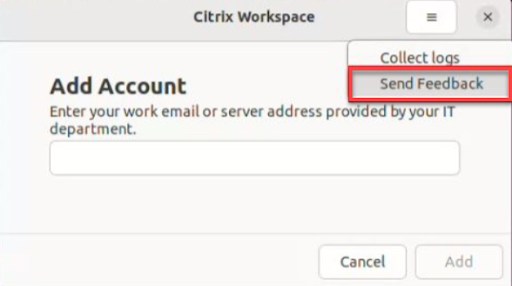
This article provides information to help administrators troubleshoot issues with Citrix Workspace app.
You might come across the following connection issues.
When establishing a connection to a Windows server, if a dialog box appears with the message “Connecting to server…” but no connection window appears later, you might need to configure the server with a Client Access License (CAL). For more information about licensing, see Licensing.
The connection might fail when reconnecting to a session with a higher color depth than that the Citrix Workspace app requires. This failure occurs when running out of available memory on the server.
If the reconnection fails, Citrix Workspace app tries to use the original color depth. Otherwise, the server tries to start a new session with the requested color depth, leaving the original session in a disconnected state. The second connection might also fail if there’s still a lack of available memory on the server.
Citrix recommends that you configure DNS (Domain Name Server) on your network. This configuration enables you to resolve the names of servers to which you want to connect. If you do not have DNS configured, it might not be possible to resolve the server name to an IP address. Instead, you can specify the server by its IP address, rather than by its name. TLS connections require a fully qualified domain name, not an IP address.
If a session does not start until you move the mouse, there might be a problem with random number generation in the Linux kernel. As a workaround, run an entropy-generating daemon such as rngd (which is hardware-based) or haveged (from Magic Software).
The Send Feedback option allows you to inform Cloud Software Group about any issues that you might run into while using Citrix Workspace app. You can also send suggestions to help us improve your Citrix Workspace app experience.
This new feature enhances the feedback experience, ensuring a more efficient and informative communication channel between users and support teams.
The Send Feedback option includes an integrated log manager, empowering users to capture and include relevant logs for a comprehensive feedback report.
Also, the Send Feedback provides seamless communication by enabling users to send feedback emails directly using the default mail client installed on their system.
The supported email clients are the following:
To configure email address for send feedback, do the following:
Add the following key in the Authmanconfig.xml file:
cwa-linux-feedback@cloud.com SendFeedbackEnabled true
Note:
By sending your feedback to Cloud Software Group, you agree your participation is in accordance with and subject to the Cloud software Group End User Agreement.
You can send feedback using any one of the following methods:

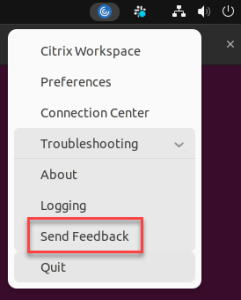
./sendfeedback
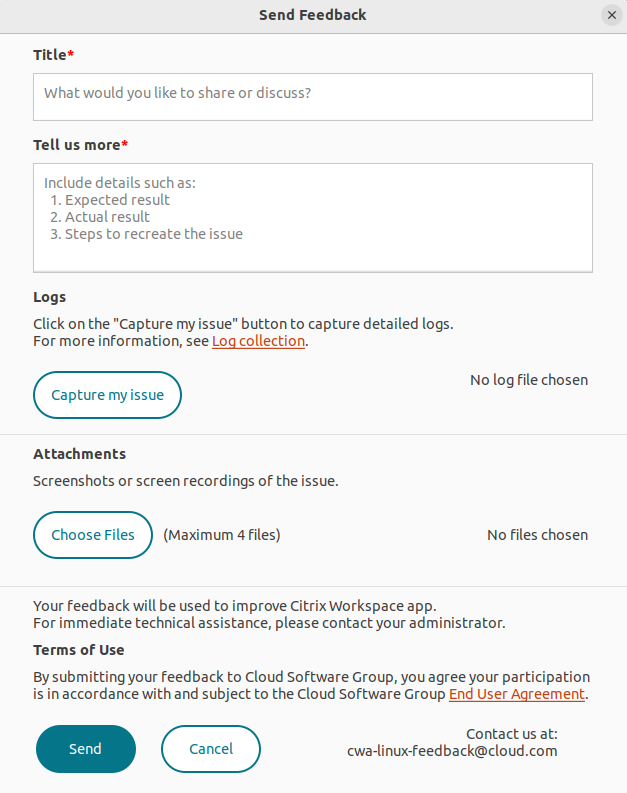
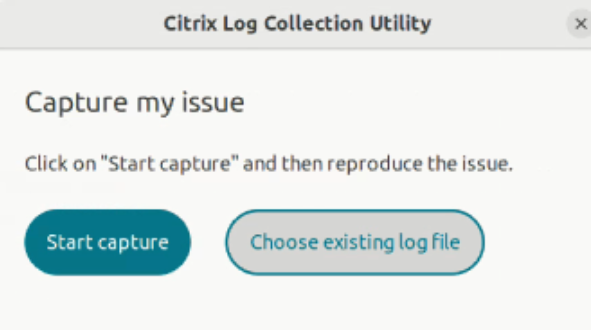 Click Start capture and then reproduce the issue to collect the latest logs. Or, Click Choose existing logs if you are not able to reproduce the issue.
Click Start capture and then reproduce the issue to collect the latest logs. Or, Click Choose existing logs if you are not able to reproduce the issue.
Note: For more information on the Citrix Log Collection Utility, see Log Collection.
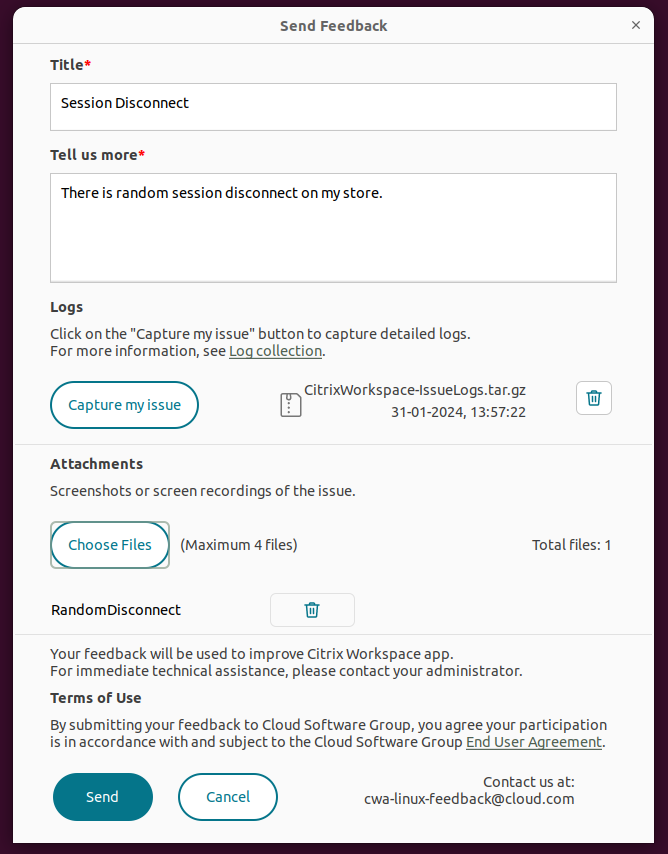
 The .tar.gz file contains the log files, the issue description as test files, and the attachments.
The .tar.gz file contains the log files, the issue description as test files, and the attachments.Note:
Ensure that the .zip file is attached in the email.
If your connection fails with the new cryptographic support:
The Citrix Optimization SDK package includes an incorrect version of the UIDialogLibWebKit.so . As a workaround, do the following:
When making a TLS connection, the Citrix Workspace app offers an advanced and restricted set of cipher suites by default.
If you’re connecting to a server that requires an older cipher suite, set the configuration option SSLCiphers=ALL in the [WFClient] section of a configuration file.
The following advanced cipher suites are supported:
When using the EDT protocol, you might see the error message: Connection to “…” has been lost. This issue might occur when the connection goes through a router with a Maximum Transmission Unit for EDT that is smaller than the default of 1,500 bytes. Do the following:
Connection errors might produce various different error dialogs. Examples are:
Some problems might cause such errors, including:
Citrix recommends you use the latest version of Citrix Virtual Apps and Desktops or Citrix DaaS (formerly Citrix Virtual Apps and Desktops service) on the server. Also, the use the latest Citrix Workspace app on the user device.
If you’re using a low-bandwidth connection, you can change your Citrix Workspace app configuration and the way you use Citrix Workspace app to improve performance.
Screen tearing occurs when parts of two (or more) different frames appear on the screen at the same time, in horizontal blocks. This issue is most visible with large areas of fast changing content on screen.
Tearing is avoided when data is captured at the VDA. Tearing isn’t introduced when data is passed to the client. However, X11 (the Linux/Unix graphics subsystem) does not provide a consistent way to draw to the screen in a way that prevents tearing.
To prevent screen tearing, Citrix recommends the standard approach which synchronizes application drawing with the drawing of the screen. That is, wait for vsvnc , to start the drawing of the next frame. Depending on the graphics hardware on the client and the window manager you’re using, the following two groups of solutions are available to prevent screen tearing:
For Intel HD graphics, create a file in the xorg.conf.d called 20-intel.conf with the following contents:
Section "Device" Identifier "Intel Graphics" Driver "intel" Option "AccelMethod" "sna" Option "TearFree" "true" EndSection For NVIDIA graphics, locate the file in the xorg.conf.d folder that includes the “MetaModes” Option for your configuration. For each comma-separated MetaMode used add the following:
Note:
Different Linux distributions use different paths to xorg.conf.d, for example, /etc/X11/xorg.conf.d, or, /user/share/X11/xorg.conf.d.
Use the following:
Note:
Use “CompizConfig Settings Manager” with caution because incorrectly changing values can prevent the system from launching.
If you’re using a non-English language keyboard, the screen display might not match the keyboard input. In this case, you must specify the keyboard type and layout that you’re using. For more information about specifying keyboards, see Control keyboard behavior.
Some window managers continuously report the new window position when moving seamless windows, which can result in excessive redrawing. To fix this problem, switch the window manager to a mode that draws only window outlines when moving a window.
The Citrix Workspace app creates window icons that are compatible with most window managers. However, these icons aren’t fully compatible with the X Inter-Client Communication Convention.
To provide full icon compatibility:
The cursor can be difficult to see if it’s the same or similar in color to the background. You can fix this issue by forcing areas of the cursor to be black or white.
To change the color of the cursor
When you move the mouse into or out of a connection window, the colors in the non-focused window start to flash. This issue is a known limitation when using the X Windows System with PseudoColor displays. If possible, use a higher color depth for the affected connection.
You have the option of using 256 colors when connecting to a server. This option assumes that the video hardware has palette support to enable applications to change the palate colors to produce animated displays.
TrueColor displays have no facility to emulate the ability to produce animations by rapidly changing the palette. Software emulation of this facility is expensive for time and network traffic. To reduce this cost, Citrix Workspace app buffers rapid palette changes, and updates the real palette only every few seconds.
Citrix Workspace app uses EUC-JP or UTF-8 character encoding for Japanese characters, while the server uses SJIS character encoding. Citrix Workspace app does not translate between these character sets. This issue can cause problems displaying:
This issue also affects Japanese characters in parameters used in extended parameter passing.
Full-screen sessions span all monitors by default, but a command-line multi-monitor display control option, -span, is also available. It allows full-screen sessions to span extra monitors.
Desktop Viewer toolbar functionality allows you to switch a session between windowed and full-screen session window, including multi-monitor support for the intersected monitors.
Important:
Span has no effect on Seamless or normal windowed sessions (including those sessions in maximized windows).
The - span option has the following format: -span [h][o][a|mon1[,mon2[,mon3, mon4]]]
If h is specified, a list of monitors is printed on stdout . If h is the whole option value, wfica exits.
If o is specified, the session window has the override-redirect attribute.
Caution:
If a is specified, Citrix Workspace app tries to create a session that covers all monitors.
Citrix Workspace app assumes that the rest of the -span option value is a list of monitor numbers:
Assuming o wasn’t specified, wfica uses the _NET_WM_FULLSCREEN_MONITORS message to request an appropriate window layout from the window manager, if it’s supported. Otherwise, it uses size and position hints to request the desired layout.
The following command can be used to test for window manager support: xprop -root | grep \_NET\_WM\_FULLSCREEN\_MONITORS
If there’s no output, there’s no support. If there’s no support, you might need an override-redirect window. You can set up an override-redirect window using -span o .
To make a session that spans extra monitors from the command line:
You might not escape from a full-screen session to use local applications or another session. This issue occurs because the client-side system UI is hidden and the Keyboard Transparency feature disables the usual keyboard command, for example Alt+Tab, sending the command to the server instead.
As a workaround, use CTRL+F2 to clear the Keyboard Transparency feature temporarily until the focus next returns to the session window. An alternative workaround is to set TransparentKeyPassthrough to No in $ICAROOT/config/module.ini. This workaround disables the Keyboard Transparency feature. However, you might have to override the ICA file by adding this setting in the All_regions.ini file.
Previously all error messages were having a default error code and a description that isn’t specific to the error. Starting with Citrix Workspace app version 2309, the error messages are improved to include the Error code, Transaction ID, and Description fields specific to the error. These error messages appear when a session starts using ICA launch or when a session starts with the Service Continuity feature enabled.
For example, if there’s a session launch failure, the following error message is displayed:

Currently, webcam redirection in Citrix Workspace app for Linux supports only one webcam at a time. The default webcam selected is mapped to the device path /dev/video0 which is, generally, the built-in webcam in laptops.
To list all devices with video capabilities in the system, you must install v4l tools using the following command:
sudo apt-get install v4l-utils
List the video devices using the following command:
v4l2-ctl --list-devices
You might receive an output as follows:
user@user-pc:~ $ v4l2-ctl --list-devices UVC Camera (046d:09a6) (usb-0000:00:14.0-1): /dev/video2 /dev/video3 /dev/media1 Integrated Camera: Integrated C (usb-0000:00:14.0-8): /dev/video0 /dev/video1 /dev/media0
As per the preceding example, there are two webcams. You can use any of them. Citrix recommends using the first index. There’s a known issue with Ubuntu, so that you might see multiple indexes for one webcam. In this example, you can use /dev/video0 and /dev/video2.
To set another capture video as default, do the following:
For example, add HDXWebCamDevice=/dev/video2 to set the webcam mapped to /dev/video2 in a system.
On the client, the webcam redirection module can be used in different modes to test isolated components under customer environment conditions.
This mode compares the video displaying on the VDA side and the actual buffers that the encoder produces on the client side. It allows to test the entire pipeline.
To enable this mode:
After this mode is enabled, the encoder generates the following files with the buffers, depending on the encoder used:
The following diagram describes the production and debug modes:
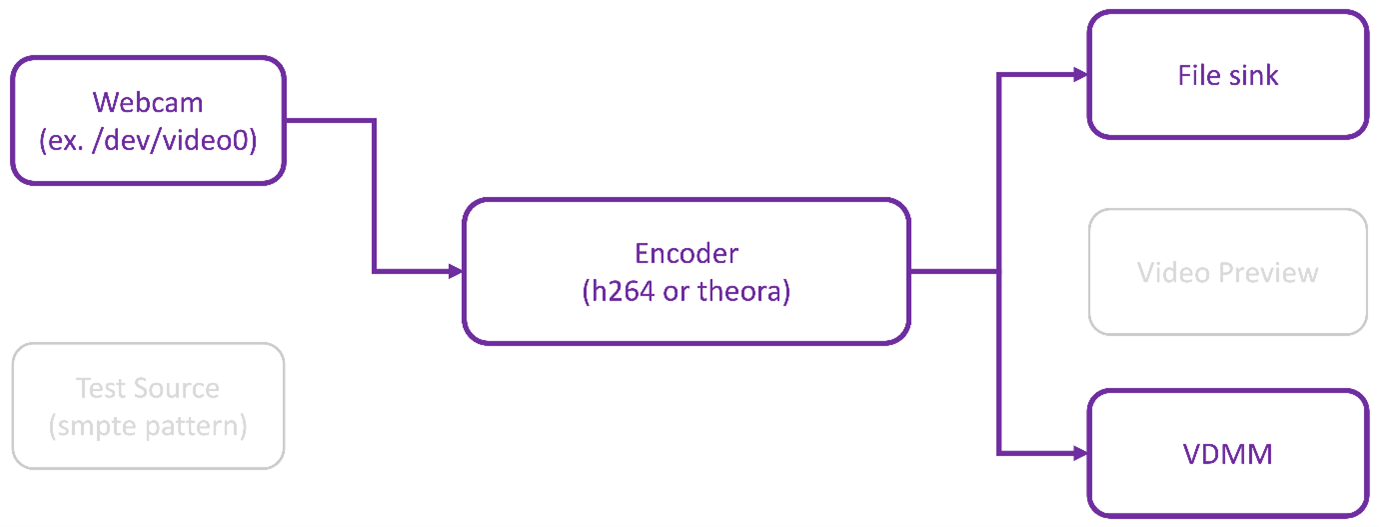
This mode allows you to test the webcam isolated from the rest of the pipeline elements.
./gst_read --buffers | -b BUFFERS_AMOUNT [ --input_device | -i WEBCAM_DEVICE; default=/dev/video0]
To enable to webcam tester mode, run the following commands from the command lines:
cd /opt/Citrix/ICAClient/util
`$./gst_read -b 100 /dev/video0
After this mode is enabled, a video preview appears and creates the following file with the raw buffers from the webcam:
The only switch required for webcam tester mode is the --buffers (-b) options. You can also specify the webcam device to test. For example, see the following:
The following diagram describes the webcam tester mode:
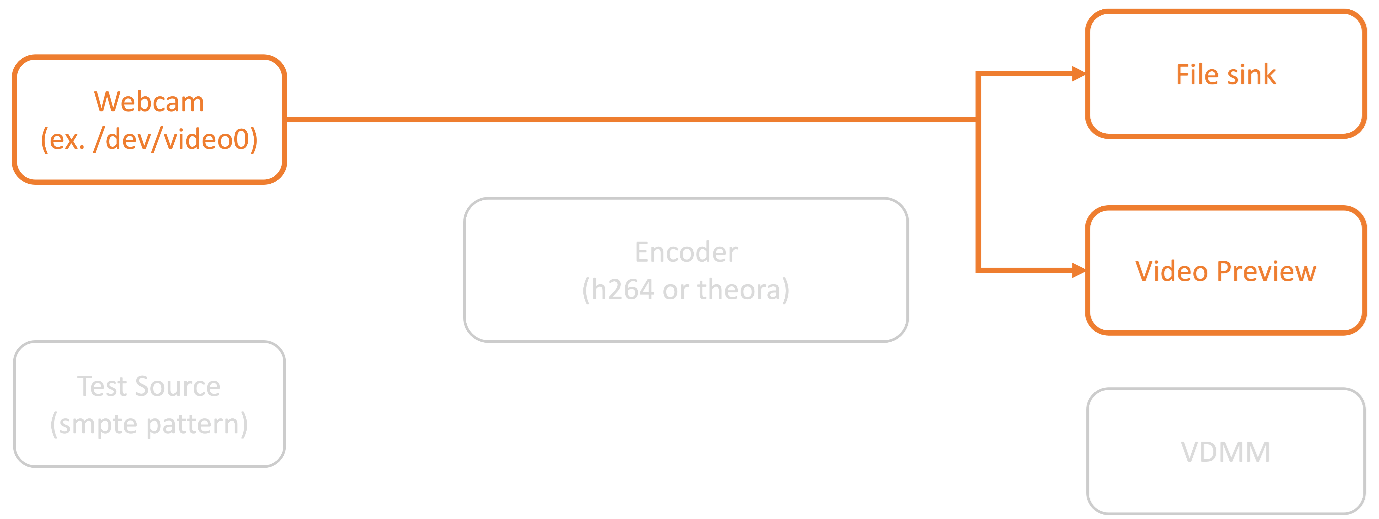
This mode allows you to test the encoder isolated from the pipeline.
./gst_read --output_file | -o FILE_NAME [ --buffers | -b BUFFER_AMOUNT; default=10 0 ] [ --enableH264 | -e ]
To enable the encoder tester mode, run the following commands from the command lines:
cd /opt/Citrix/ICAClient/util
./gst_read -o ~/file_buffers.h264 -e
The only switch required for this mode is the --output_file (-o) options. You can also test Theora or H264 encoders and the amount of buffer to generate. For example, see the following:
The following diagram describes the encoder tester mode:
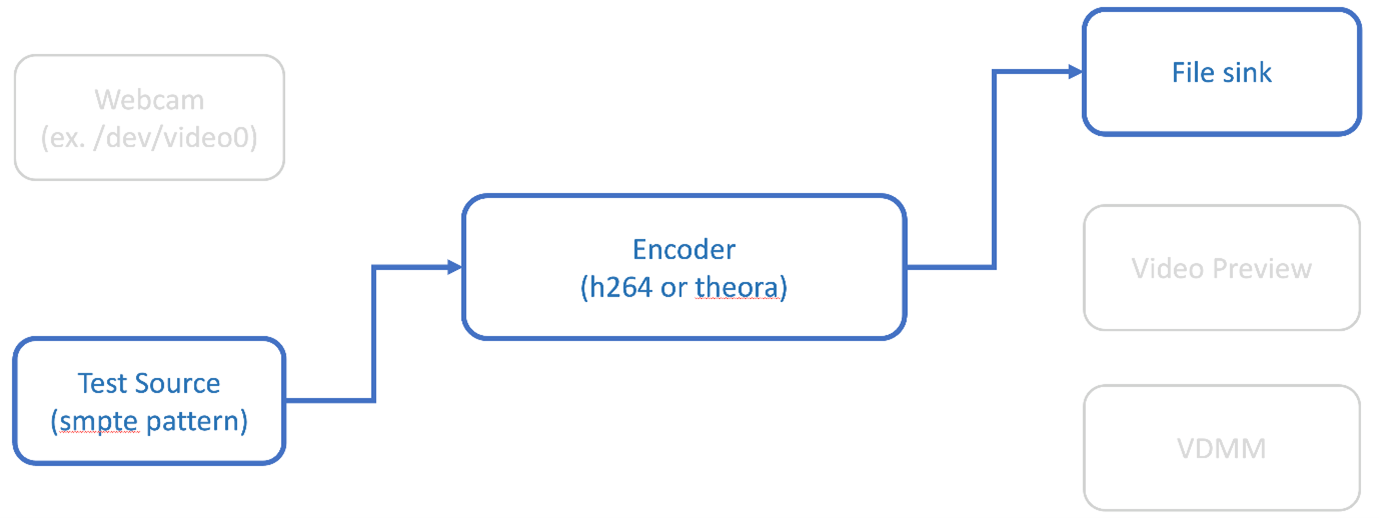
If the software-based H264 encoder does not work correctly, you must verify its dependencies using the following steps:
gst-inspect-1.0 x264
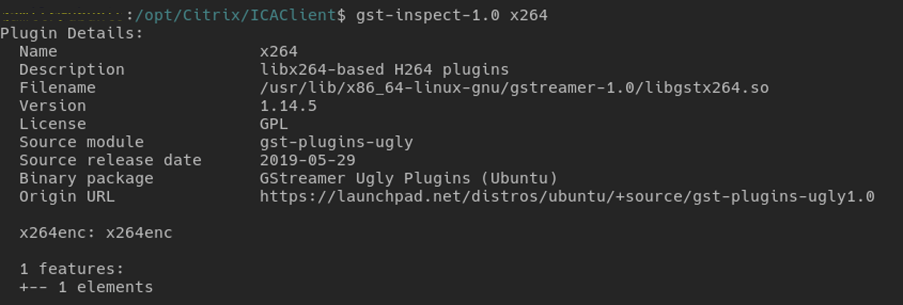
Run the following command to verify the dependencies of the libgstx264.so library:
ldd /usr/lib/x86_64-linux-gnu/gstreamer-1.0/libgstx264.so
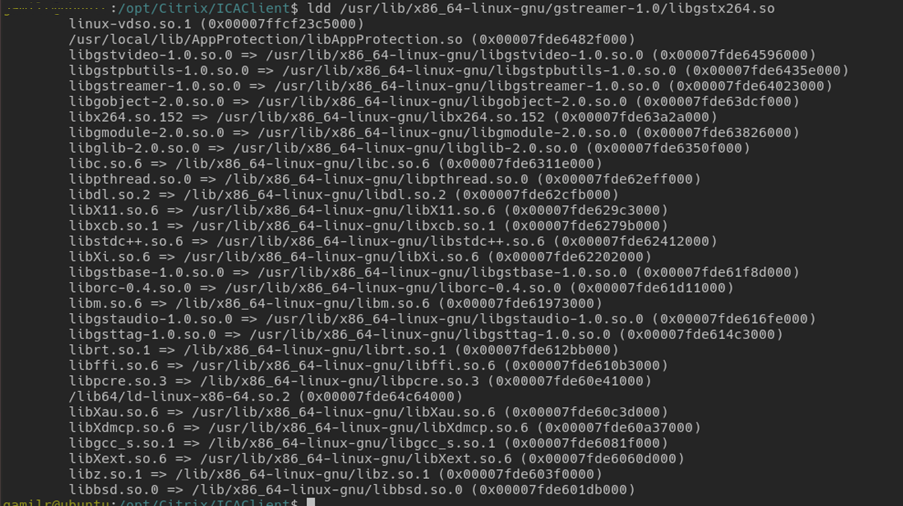
If the libgstx264.so file isn’t present, you must install GStreamer plugins ugly using the following command:
sudo apt-get install gstreamer1 0-plugins-ugly
gst-inspect-1.0 vaapi
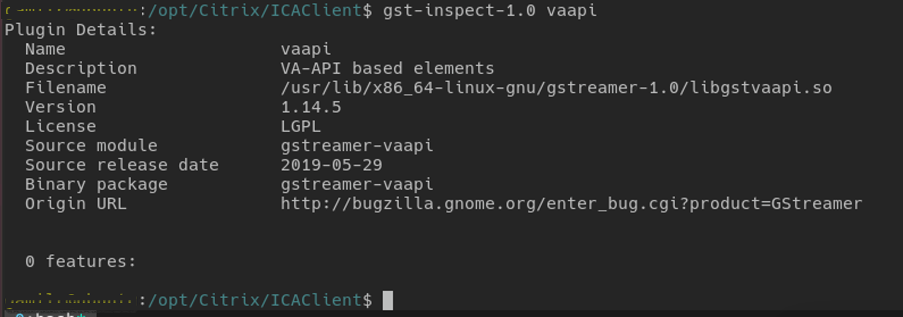
Run the following command to verify the dependencies of the libgstvaapi.so library:
ldd /usr/lib/x86_64-linux-gnu/gstreamer-1.0/libgstvaapi.so

To install and configure vaapi , follow the GStreamer vappi installation guide.
Alternative to regular ICAClient logs, you must collect the logs from the gst_read module.
Do the following to collect the logs:
export GST_DEBUG=2, gst_read_debug:6
export GST_DEBUG_FILE=~/gst_read.log
Note: This variable sets the level of log collection and the file to store them. In this case, we’re setting level 2 for the GStreamer framework and level 7 for the gst_read module. For more information, see the document. It’s recommended only to set error and warning levels for the internal GStreamer framework and log level for gst_read .
cd /opt/Citrix/ICAClient
./wfica /vda.ica
The gst_read.log file is generated with the internal GStreamer framework and the gst_read logs.
To see the actual pipelines that the GStreamer framework is creating, do the following:
cd /opt/Citrix/ICAClient/
./wfica /vda.ica

Pipeline successfully created:

Pipeline unable to link:

Note:
To enlarge the preceding images or any other images, right-click the image, select Open image in new tab, and zoom the browser as required.
As shown in the preceding image, the second pipeline is unable to link the GstCapsFilter element and the GstVaapiEncodeH264 element. The capabilities are never fully negotiated. For more information, see the document.
We provide a script, rave_troubleshooting.sh to verify whether the system configuration and dependencies are suitable to support Remote Audio Video Extensions (RAVE).
Note:
RAVE is an HDX feature to support optimized webcam redirection and Windows Media Player redirection for Citrix VDAs.
Do the following to run the script:
The system configuration and dependencies are displayed.
You can redirect Android phones as generic USB as follows:
lsusb
CONNECT vid=18d1 pid=4ee2 split=01 intf=00
When you click a link in a Windows session, the content appears in a local browser. Server-client content redirection is enabled in wfclient.ini. This redirection causes a local application to run. To disable server-client content redirection, see server-client content redirection.
When you access published resources, your browser prompts to save a file. Browsers other than Firefox and Chrome might require configuration before you can connect to a published resource. However, when trying to access a resource by clicking an icon on the page, your browser prompts you to save the ICA file.
If you have problems using a specific web browser, set the environment variable BROWSER to specify the local path and name of the required browser before running setupwfc .
When you launch desktops or applications in Firefox, if a page is unresponsive, try enabling the ICA plug-in.
When the ICA plug-in is enabled in Firefox, desktop and application sessions might not start. In this case, try disabling the ICA plug-in.
These errors might occur if you configured a connection entry incorrectly.
E_MISSING_INI_SECTION - Verify the configuration file: “…”. The section “…” is missing in the configuration file.
The configuration file was incorrectly edited or is corrupt.
E_MISSING_INI_ENTRY - Verify the configuration file: “…”. The section “…” must contain an entry “…”.
The configuration file was incorrectly edited or is corrupt.
E_INI_VENDOR_RANGE - Verify the configuration file: “…”. The X server vendor range “…” in the configuration file is invalid.
The X Server vendor information in the configuration file is corrupt. Contact Citrix.
These errors might occur if you edited wfclient.ini incorrectly.
E\_CANNOT\_WRITE\_FILE - Cannot write file: ". "
There was a problem saving the connection database; for example, no disk space.
E\_CANNOT\_CREATE\_FILE - Cannot create file: ". "
There was a problem creating a connection database.
E_PNAGENT_FILE_UNREADABLE - Cannot read Citrix Virtual Apps file “…”: No such file or directory.
Cannot read Citrix Virtual Apps file “…”: Permission denied.
You’re trying to access a resource through a desktop item or menu, but the Citrix Virtual Apps and Desktops or Citrix DaaS file for the resource isn’t available. Refresh the list of published resources by selecting Application Refresh on the View menu, and try to access the resource again. If the error persists:
For information on how to troubleshoot Browser Content Redirection, see the Knowledge Center article CTX230052.
Run the following command in the terminal to import the self-signed certificate into nssdb :
certutil -A -n "badssl.cer" -t "C,," -d ~/.pki/nssdb -i ~/Downloads/badssl.cer
The arguments in the commands are:
For information about BCR, see the Browser content redirection page in the Citrix Virtual Apps and Desktops documentation.
You might also find the following issues.
To know whether the server has instructed Citrix Workspace app to close a session, use the wfica program. This program logs when it has received a command to terminate the session from the server.
To record this information through the syslog system, add SyslogThreshold with the value 6 to the [WFClient] section of the configuration file. This setting enables the logging of messages that have a priority of LOG_INFO or higher. The default value for SyslogThreshold is 4 (=LOG_WARNING).
Similarly, to have wfica , send the information to standard error and add PrintLogThreshold with the value 6 to the [WFClient] section. The default value for PrintLogThreshold is 0 (=LOG_EMERG).
For more information on log collection, see Log collection and for more information on syslog configuration, see syslog configuration.
For each entry in wfclient.ini, there must be a corresponding entry in All_Regions.ini for the setting to take effect. Also, for each entry in the [Thinwire3.0], [ClientDrive], and [TCP/IP] sections of wfclient.ini, there must be a corresponding entry in canonicalization.ini for the setting to take effect. See the All_Regions.ini and canonicalization.ini files in the $ICAROOT/config directory for more information.
If you have issues running published applications that access a serial port, the application might fail (with or without an error message, depending on the application itself) if the port has been locked by another application. In such circumstances, check that there are no applications that have either temporarily locked the serial port or have locked the serial port and exited without releasing it.
To overcome this problem, stop the application that is blocking the serial port. Regarding UUCP-style locks, there might be a lock file left behind after the application exits. The location of these lock files depends on the operating system used.
If Citrix Workspace app does not start, the error message “Application default file could not be found or is out of date” appears. The reason might be that the environment variable ICAROOT isn’t defined correctly. This variable is a requirement if you installed Citrix Workspace app to a non-default location. To overcome this problem, Citrix recommends that you do one of the following:
To find the Citrix CryptoKit (formerly SSLSDK) or OpenSSL version number that you’re running, you can use the following command: strings libctxssl.so | grep "Citrix SSLSDK"
You can also run this command on AuthManagerDaemon or PrimaryAuthManager
If your window manager uses the same key combinations to provide native functionality, your key combinations might not function correctly. For example, the KDE window manager uses the combinations from CTRL+SHIFT+F1 to CTRL+SHIFT+F4 to switch between desktops 13 to 16. If you experience this problem, try the following solutions:
This procedure ensures that ASCII characters are correctly sent to remote virtual desktops with Croatian keyboard layouts.
To configure the use of a Japanese keyboard, update the following entry in the wfclient.ini configuration file:
To configure the use of an ABNT2 keyboard, update the following entry in the wfclient.ini configuration file:
If some keys on the local keyboard do not behave as expected, choose the best-matching server layout from the list in $ICAROOT/config/module.ini.
Citrix Workspace app might not have GStreamer plugins to handle a requested format. This issue normally causes the server to request a different format. Sometimes the initial check for a suitable plug-in incorrectly indicates that one is present. This issue is normally detected and causes an error dialog to appear on the server that indicates the Windows Media Player found a problem while playing the file. Retrying the file within the session typically works because Citrix Workspace app rejects the format. And as a result, the server either requests another format or provides the media itself.
In a few situations, there’s no suitable plug-in is detected and the file isn’t played correctly, despite the progress indicator moving as expected in the Windows Media Player.
To avoid this error dialog or failure to play in future sessions:
Note:
Alternately, after identifying the mime type it might be possible to install a GStreamer plugin to decode it.
With the 2307 release, a new bash script is introduced to verify the configuration required for the Windows Media Player redirection feature in the Citrix Workspace app for Linux. This feature helps to reduce troubleshooting time for the Windows Media Player redirection feature. To verify the configuration, you can use the same rave_troubleshooting.sh available at System diagnostic script for RAVE.
To configure a single serial port, add the following entries in the $ICAROOT/config/module.ini configuration file:
To configure two or more serial ports, add the following entries in the $ICAROOT/config/module.ini configuration file:
This topic includes a list of other common error messages that you might see when using Citrix Workspace app.
An error occurred. The error code is 11 (E_MISSING_INI_SECTION). Please refer to the documentation. Exiting.
When running Citrix Workspace app from the command line, this error usually means the description given on the command line wasn’t found in the appsrv.ini file.
E_BAD_OPTION - The option “…” is invalid.
Missing argument for option “…”.
E_BAD_ARG - The option “…” has an invalid argument: “…”.
Invalid argument specified for option “…”.
E_INI_KEY_SYNTAX - The key “…” in the configuration file “…” is invalid.
The X Server vendor information in the configuration file is corrupt. Create a configuration file.
E_INI_VALUE_SYNTAX - The value “…” in the configuration file “…” is invalid.
The X Server vendor information in the configuration file is corrupt. Create a configuration file.
E_SERVER_NAMELOOKUP_FAILURE - Cannot connect to server “…”.
The server name can’t be resolved.
Cannot write to one or more files: “…”. Correct any disk full issues or permissions problems and try again.
Check for disk-full issues, or permissions problems. If a problem is found and corrected, retry the operation that prompted the error message.
Server connection lost. Reconnect and try again. These files might be missing data: “…”.
Reconnect and retry the operation that prompted the error.
If you are experiencing problems using Citrix Workspace app, you might be asked to provide Technical Support with diagnostic information. This information assists this team in trying to diagnose the problem and offer assistance to rectify it.
To obtain diagnostic information about Citrix Workspace app:
Users can manage their active connections using the Connection Center. This feature is a useful productivity tool that enables users and administrators to troubleshoot slow or problematic connections. With Connection Center, users can manage connections by:
In earlier versions, the debug.ini and module.ini files were used to configure logging.
As of version 2009, you can configure the log collection using one of the following methods:
Also as of Version 2009, the debug.ini configuration file is removed from the Citrix Workspace app installer package.
Logs capture the Citrix Workspace app deployment details, configuration changes, and administrative activities to a log collection database. A third-party developer can apply this log collection mechanism by using the log collection SDK, which is bundled as part of the Citrix Workspace app Platform Optimization SDK.
You can use the log information to:
If Citrix Workspace app is installed with root user privileges, the logs are stored in the /var/log/citrix/ICAClient.log . Otherwise, the logs are stored in $/.ICAClient/logs/ICAClient.log .
When Citrix Workspace app is installed, a user called citrixlog is created to handle the logging functionality.
All the available commands are displayed.
The following table lists various modules and their corresponding trace class values. Use the following table for a specific command-line log value set:
| Module | Log class |
|---|---|
| Assertions | LOG_ASSERT |
| Audio Monitor | TC_CM |
| BCR with CEF | TC_CEFBCR |
| Client Audio Mapping | TC_CAM |
| Connection Center | TC_CONNCENTER |
| Client Communication Port | TC_CCM |
| Client Drive Mapping | TC_CDM |
| Clip | TC_CLIP |
| Client Printer Mapping | TC_CPM |
| Client Printer Mapping | TC_CPM |
| Font | TC_FONT |
| Frame | TC_FRAME |
| Graphics Abstraction | TC_GA |
| Input Method Editor | TC_IME |
| IPC | TC_IPC |
| Keyboard Mapping | TC_KEY |
| Licensing Driver | TC_VDLIC |
| Multimedia | TC_MMVD` |
| Mouse Mapping | TC_MOU |
| MS Teams | TC_MTOP |
| Other Libraries | TC_LIB |
| Protocol Driver | TC_PD |
| PNA Store | TC_PN |
| Standard Event Logs | LOG_CLASS |
| SRCC | TC_SRCC |
| SSPI Login | TC_CSM |
| Smart Card | TC_SCARDVD |
| Selfservice | TC_SS |
| Selfservice Extension | TC_SSEXT |
| StorefrontLib | TC_STF |
| Transport Driver | TC_TD |
| Thinwire | TC_TW |
| Transparent Window Interface | TC_TUI |
| Virtual Channel | TC_VD |
| PAL | TC_VP |
| UI | TC_UI |
| UIDialogLibWebKit3 | TC_UIDW3 |
| `UIDialogLibWebKit3_ext | TC_UIDW3E |
| USB Daemon | TC_CTXUSB |
| Video Frame Driver | TC_VFM |
| Web kit | TC_WEBKIT |
| WinStation Driver | TC_WD |
| Wfica | TC_NCS |
| Wfica Engine | TC_WENG |
| Wfica Shell | TC_WFSHELL |
| Web helper | TC_WH |
| Zero Latency | TC_ZLC |
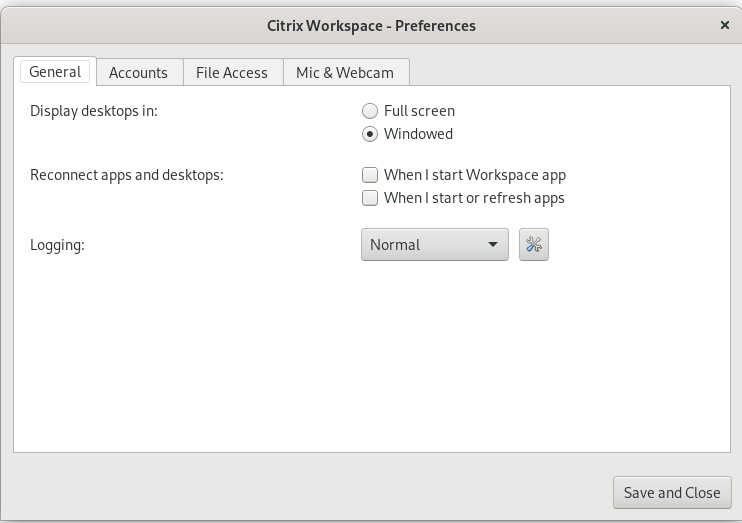
Go to Menu > Preferences. The Citrix Workspace-Preferences dialog appears.
At increasing levels of tracing detail, the following values are available:
By default, the Logging option is set to Only Error.
Due to the large amount of data that can be generated, tracing might significantly impact the performance of Citrix Workspace app. The Verbose level is recommended only if necessary for troubleshooting.
Click Save and Close after you select the desired log collection level. The changes are applied in the session dynamically.
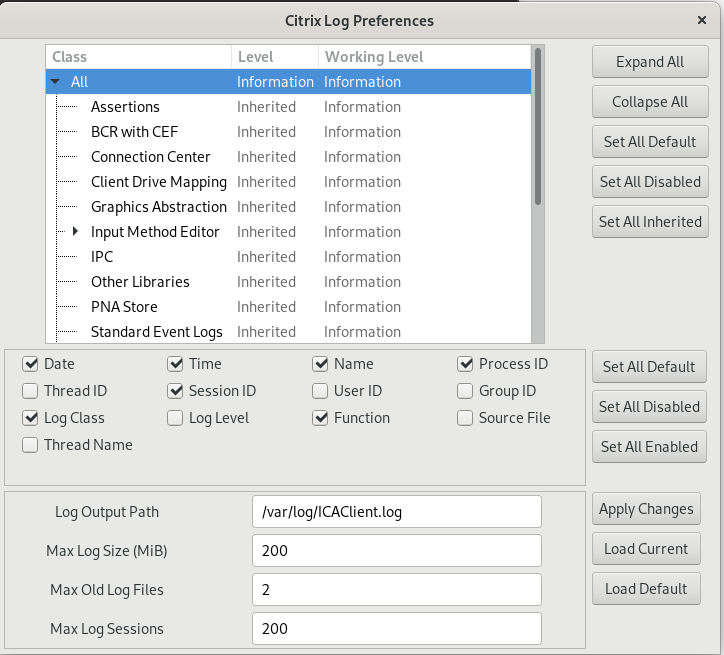
Click the settings icon next to the Logging option drop-down menu. The Citrix Log Preferences dialog appears.
Note:
If you delete the ICAClient.log file, you must restart the log collection service ctxcwalogd .
For example, if you are on a systemd-capable setup, run the following command:
systemctl restart ctxcwalogd .
Enabling log collection on Version 2006 and earlier:
If you are on Version 2006 and earlier, enable log collection using the following procedure:
The following table lists the wfica modules and their corresponding trace class values:
| Module | TraceClasses value |
|---|---|
| Graphics | TC_TW |
| EUEM | TC_EUEM |
| WFICA (Session Launch) | TC_NCS |
| Printing | TC_CPM |
| Connection Sequence - WD | TC_WD |
| Connection Sequence - PD | TC_PD |
| Connection Sequence - TD | TC_TD |
| Proxy related files | TC_PROXY |
| Multimedia Virtual Driver / Webcam | TC_MMVD |
| Virtual Drivers | TC_VD |
| Client Drive Mapping | TC_CDM |
| Audio | TC_CAM |
| COM (Communication Port) | TC_CCM |
| Seamless | TC_TWI |
| Smart Card | TC_SCARDVD |
The following table lists the connection center module and their corresponding trace class value:
| Module | TraceClasses value |
|---|---|
| Connection center | TC_CSM |
The following table lists the trace class value for setWebHelper:
| TraceClasses value |
|---|
| Set logSwitch to 1 (to enable) or 0 (to disable) |
| Example: logSwitch = 1 |
Troubleshooting:
If ctxcwalogd turns unresponsive, the logs are traced in the syslog.
For information about getting new and refreshed logs in subsequent launches, see Syslog configuration.
By default, all syslog logs are saved at /var/log/syslog . To configure the path and the name of the log file, edit the following line under the [RULES] section in the /etc/rsyslog.conf file. For example,
user.* -/var/log/logfile_name.log Save your changes and then restart the syslog service using the command:
sudo service rsyslog restart
Points to remember:
To enable remote log collection on:
Previously, there was no tool available to collect the log files in Citrix Workspace app. Log files were present in different folders. You had to manually collect log files from different folders.
Starting with the 2109 version, Citrix Workspace app introduces a collectlog.py tool to collect log files from different folders. You can run the tool using the command-line. The log files are generated as a compressed log file. You can download it from the local server.
Starting with Version 2109, two new files are added to collect log files using the collectlog.py tool:
By default, the [hdxteams] component is added in the logcollector.ini file to collect log files for Microsoft Teams. However, you can add other components also in the logcollector.ini file using the following procedure:
If you are on Version 2109, collect log files using the following procedure:
Note:
The default path of the logcollector.ini configuration file is /opt/Citrix/ICAClient/config/logcollector.ini . The default path of the compressed log file is /tmp .
Note:
The log files are saved in the /tmp folder with the file name cwalog_.tar.gz .
Starting with Citrix Workspace app version 2309, the following enhancements are available:
The Citrix Log Collection Utility helps you collect both new and existing logs. This utility specifically collects verbose logs and saves all logs in a tar.gz file.
You can open the Citrix Log Collection Utility by using any one of the following methods:

Click Troubleshooting > Collect logs in the App indicator icon.
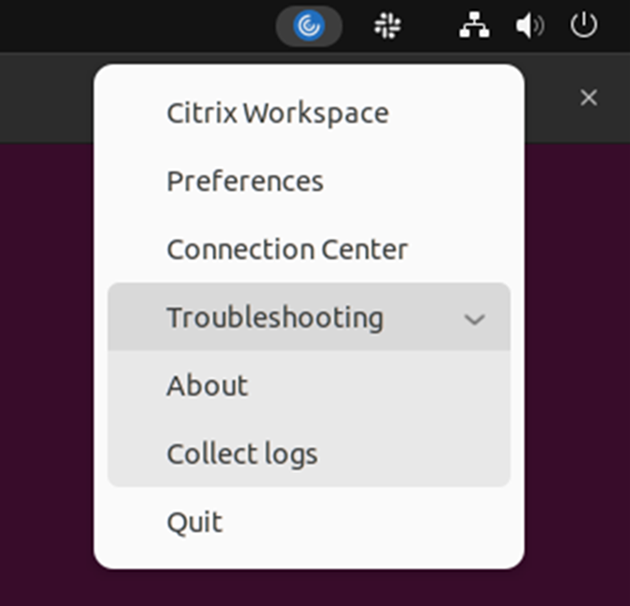
The Citrix Log Collection utility screen appears.
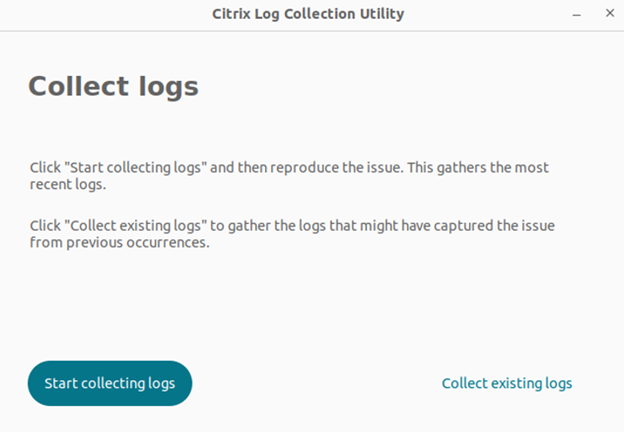
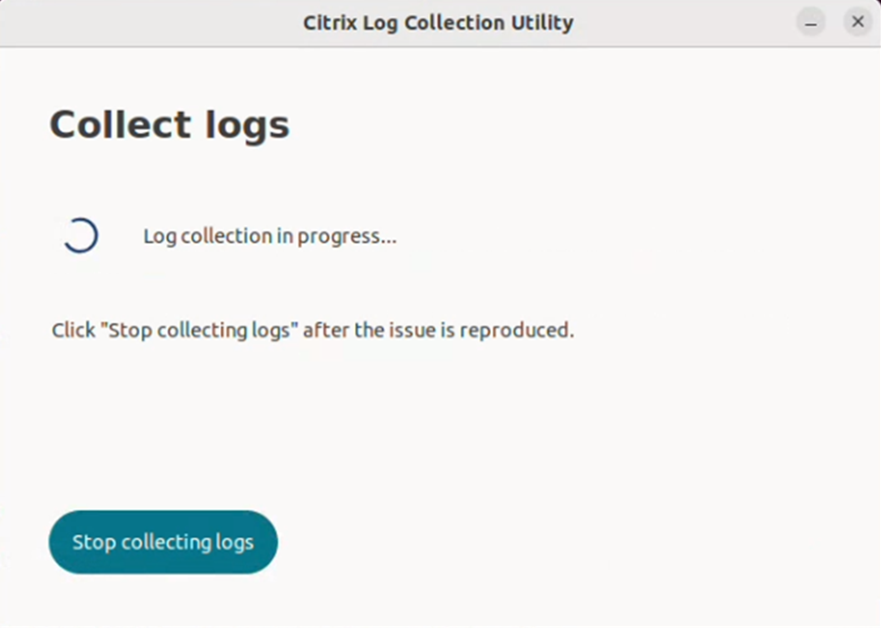
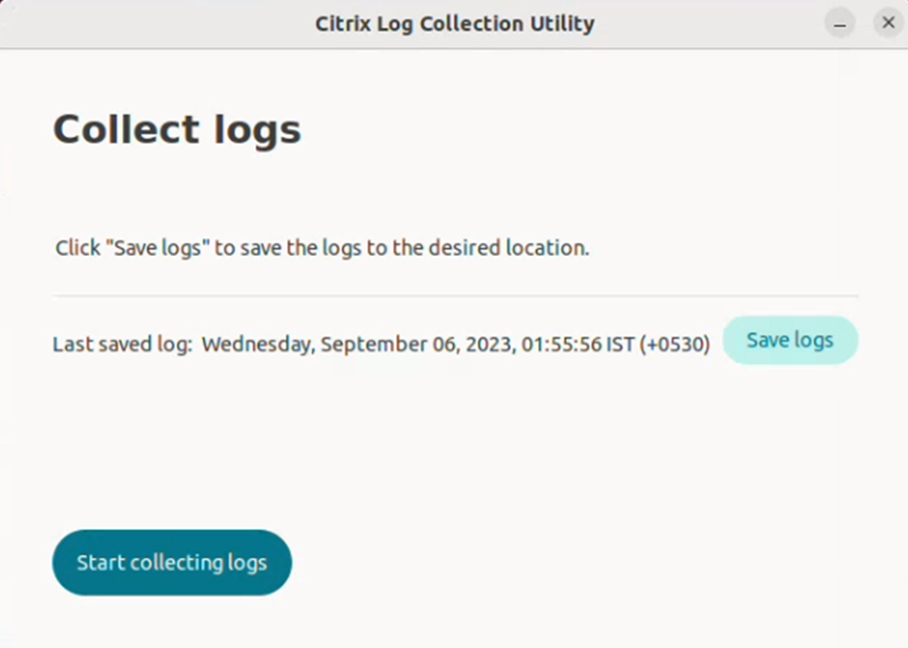

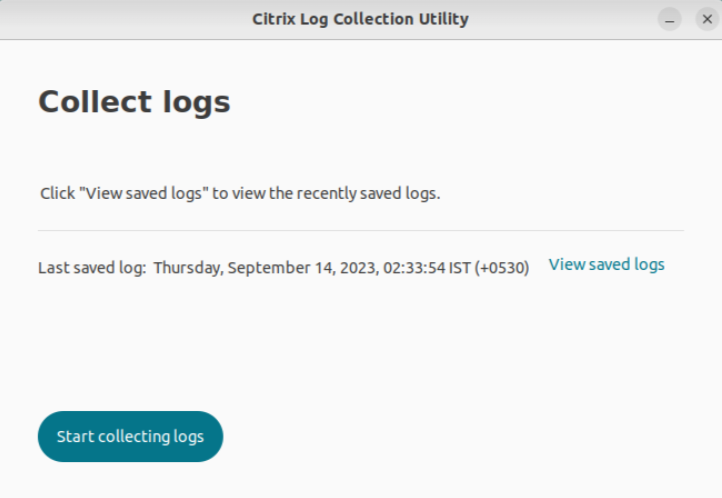
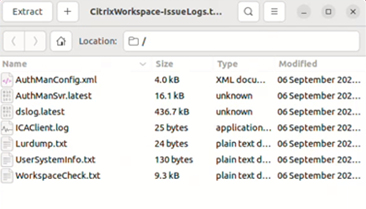

Note:
If you click Start collecting logs for the second time, you get a warning message to overwrite the existing logs:
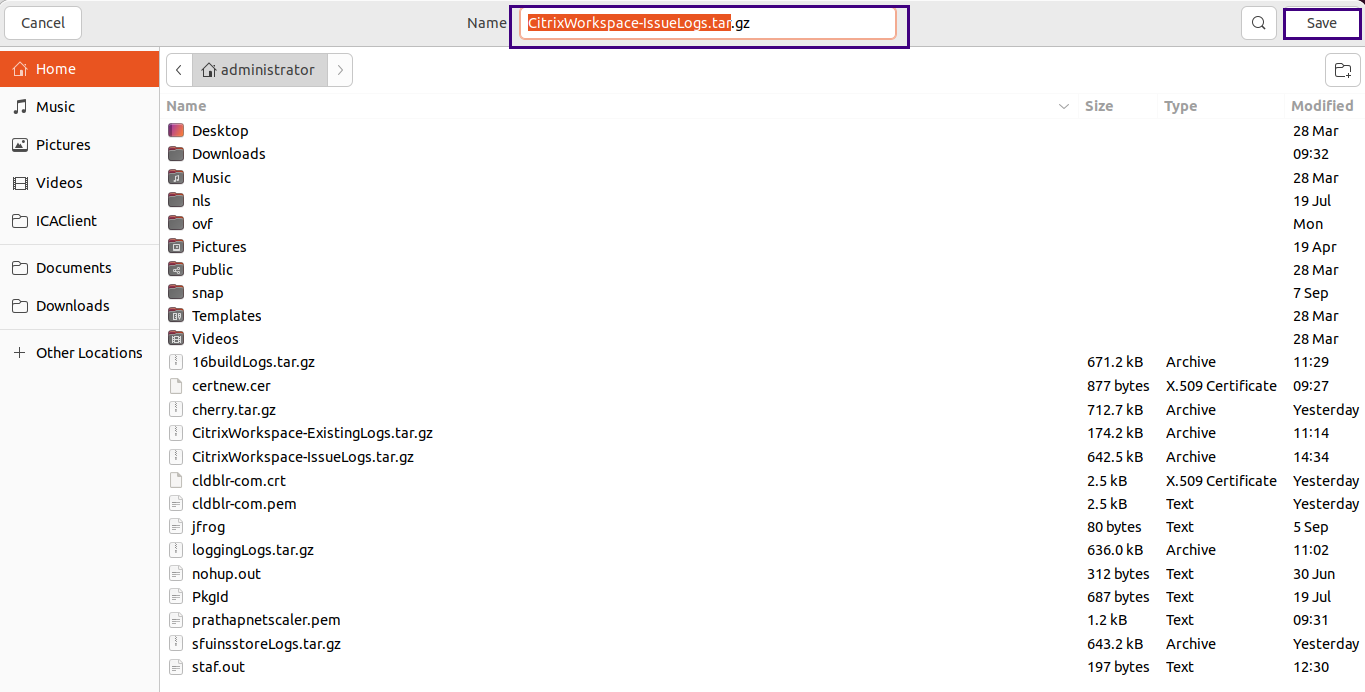
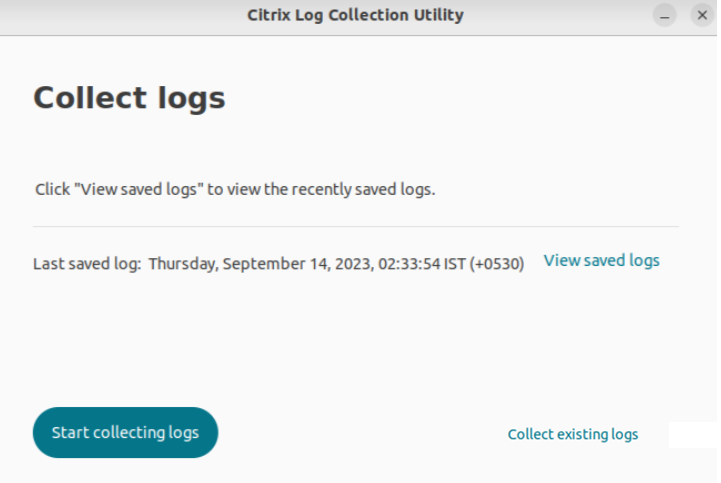

Starting with the 2311 version, you can collect the user activity logs. Activities related to most of the Storebrowse commands are saved in the log file. You can find the log files within the following location:
By default, the user activity logs are enabled. To disable it, add the following key in the Authmanconfig.xml file:
UserActivityLogsDisabled true
DS logs collects all logs. If you don’t require the dslogs , you can disable it by adding the following key in the Authmanconfig.xml file:
DsLogsDisabled true
Starting with the 2405 version, browser content redirection now allows admins to monitor the feature status as part of the enhancements to the system logs. For more information, see Browser content redirection.
The official version of this content is in English. Some of the Cloud Software Group documentation content is machine translated for your convenience only. Cloud Software Group has no control over machine-translated content, which may contain errors, inaccuracies or unsuitable language. No warranty of any kind, either expressed or implied, is made as to the accuracy, reliability, suitability, or correctness of any translations made from the English original into any other language, or that your Cloud Software Group product or service conforms to any machine translated content, and any warranty provided under the applicable end user license agreement or terms of service, or any other agreement with Cloud Software Group, that the product or service conforms with any documentation shall not apply to the extent that such documentation has been machine translated. Cloud Software Group will not be held responsible for any damage or issues that may arise from using machine-translated content.
DIESER DIENST KANN ÜBERSETZUNGEN ENTHALTEN, DIE VON GOOGLE BEREITGESTELLT WERDEN. GOOGLE LEHNT JEDE AUSDRÜCKLICHE ODER STILLSCHWEIGENDE GEWÄHRLEISTUNG IN BEZUG AUF DIE ÜBERSETZUNGEN AB, EINSCHLIESSLICH JEGLICHER GEWÄHRLEISTUNG DER GENAUIGKEIT, ZUVERLÄSSIGKEIT UND JEGLICHER STILLSCHWEIGENDEN GEWÄHRLEISTUNG DER MARKTGÄNGIGKEIT, DER EIGNUNG FÜR EINEN BESTIMMTEN ZWECK UND DER NICHTVERLETZUNG VON RECHTEN DRITTER.
CE SERVICE PEUT CONTENIR DES TRADUCTIONS FOURNIES PAR GOOGLE. GOOGLE EXCLUT TOUTE GARANTIE RELATIVE AUX TRADUCTIONS, EXPRESSE OU IMPLICITE, Y COMPRIS TOUTE GARANTIE D'EXACTITUDE, DE FIABILITÉ ET TOUTE GARANTIE IMPLICITE DE QUALITÉ MARCHANDE, D'ADÉQUATION À UN USAGE PARTICULIER ET D'ABSENCE DE CONTREFAÇON.
ESTE SERVICIO PUEDE CONTENER TRADUCCIONES CON TECNOLOGÍA DE GOOGLE. GOOGLE RENUNCIA A TODAS LAS GARANTÍAS RELACIONADAS CON LAS TRADUCCIONES, TANTO IMPLÍCITAS COMO EXPLÍCITAS, INCLUIDAS LAS GARANTÍAS DE EXACTITUD, FIABILIDAD Y OTRAS GARANTÍAS IMPLÍCITAS DE COMERCIABILIDAD, IDONEIDAD PARA UN FIN EN PARTICULAR Y AUSENCIA DE INFRACCIÓN DE DERECHOS.
本服务可能包含由 Google 提供技术支持的翻译。Google 对这些翻译内容不做任何明示或暗示的保证,包括对准确性、可靠性的任何保证以及对适销性、特定用途的适用性和非侵权性的任何暗示保证。このサービスには、Google が提供する翻訳が含まれている可能性があります。Google は翻訳について、明示的か黙示的かを問わず、精度と信頼性に関するあらゆる保証、および商品性、特定目的への適合性、第三者の権利を侵害しないことに関するあらゆる黙示的保証を含め、一切保証しません。
ESTE SERVIÇO PODE CONTER TRADUÇÕES FORNECIDAS PELO GOOGLE. O GOOGLE SE EXIME DE TODAS AS GARANTIAS RELACIONADAS COM AS TRADUÇÕES, EXPRESSAS OU IMPLÍCITAS, INCLUINDO QUALQUER GARANTIA DE PRECISÃO, CONFIABILIDADE E QUALQUER GARANTIA IMPLÍCITA DE COMERCIALIZAÇÃO, ADEQUAÇÃO A UM PROPÓSITO ESPECÍFICO E NÃO INFRAÇÃO.